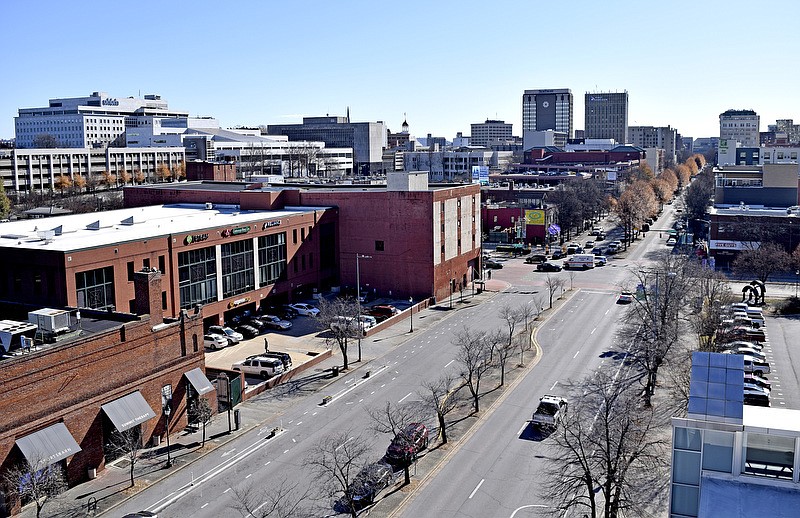NASHVILLE - Tennessee's population is estimated to grow by 1 million over the next 20 years to nearly 7.8 million, according to the Boyd Center for Business and Economic Research at the University of Tennessee.
Half of the growth is expected to occur in Middle Tennessee. That population is soaring as a number of people flock to trendy Nashville and nearby communities, along with a number of national and international companies moving some operations or even their corporate headquarters to the region.
Because of those trends, Hamilton County is now expected to lose its status as the state's fourth most populous county in just six years to Rutherford County (Murfreesboro), which adjoins Metro Nashville.
Hamilton County's population is expected to grow between 2018 to 2026 from 364,286 to 384,624 people, a 20,338-person or 5.5% increase. But Rutherford's 2018 population of 324,890 is pegged to see nearly 20% growth, taking it to 389,816 by 2026 and edging out Hamilton.
By 2040, the Boyd Center estimates Hamilton's population will be 492,535 people, while Rutherford would be at 505,396.
Hamilton County Mayor Jim Coppinger noted Rutherford County is larger than Hamilton in terms of square miles and Rutherford's topography is "pretty flat" to boot.
"The other thing is there's been such a boom in Nashville and they've certainly probably benefited from that," Coppinger added. "I don't look at it as something we're competing against them on."
"Bigger isn't always better," said Chattanooga Mayor Andy Berke. "Chattanooga isn't trying to be the next Atlanta, Nashville or Dallas. We're focused on having the right growth and scale to bring a quality of life that is best for our community."
Boyd Center associated professor Matthew Harris, author of the study, estimates Tennessee's population was 6.77 million in 2018. After projected growth to 7.8 million in 2040, the state's population is expected to hit 9.35 million in 2070. But the projected annual growth rate by then is seen as slowing down to 0.45%.
"We expect population to grow more slowly over the coming decades than it has recently," Harris said in a news release. "Falling birth rates and the fact that a very large cohort - the baby boomers - are aging both contribute to the decrease in population growth."
Overall changes in Tennessee's population as well as the composition of it are expected to pose societal challenges and also have political consequences. One out of every five Tennesseans will be 65 or older by 2040.
And Middle Tennessee's growing political might at the state level - congressional and legislative seats are apportioned by population - likely will continue. And that could have repercussions.
Tim Kuhn, director of the Tennessee State Data Center, analyzed the data and is projecting that more than half of the growth by 2040 will be in Middle Tennessee, with Davidson, Williamson, Rutherford, Wilson and Sumner counties expected to gain more than a half million residents.
Statewide, 66 counties will see population increases. But 27 rural counties will lose population, according to Kuhn.
Carter and Sullivan counties in Upper East Tennessee are the only urban counties expected to see population losses by 2040. They're slight - 0.46% and 0.01%, respectively.
The number of people age 65 and older is likely to increase by 1.9% annually, or 2.6 times faster than the state's growth rate. The number of seniors is expected to rise 46.7% by 2040.
Factors such as declining death rates and more retirees moving to Tennessee are driving the aging population.
"The benefit of longer life expectancy and the overall attractiveness of Tennessee to retirees will also present challenges as this age group grows," Kuhn said. "In areas such as housing and transportation, both urban and rural communities will be challenged to address the growing demand for senior services. This isn't unique to Tennessee; it is becoming more of an issue across the nation and around the world."
But an aging population also means a drop in the percentage of working-age adults ages 20 to 64. It's expected to fall from 58.9% in 2018 to 54.9% by 2040.
"Particularly in rural counties, we may be somewhat concerned about the ratio of working-age adults to retirees," Harris said. "That has implications for local tax bases and the types of services that the population needs."
Depending on the extent that caring for older relatives "decreases engagement in the workforce, effects of this demographic shift on actual labor force participation may be even more pronounced," Harris said.
Other findings include:
- Rutherford on the rise: After its anticipated replacement of Hamilton County as the state's fourth most populous county in 2026, Rutherford County will be knocking on the door of Knox County, now the state's third most populous county. It's likely to depose Knox as No. 3 by 2050.
- The state's white, non-Hispanic population will decrease from 73.7% in 2018 to 66.6% by 2040 and 55.1% by 2070. This decline will occur in all Tennessee counties.
- The Hispanic population is projected to almost double from 5.6% to 10.2% by 2040, bringing it to about 800,000.
- With 1.32 million residents, the black non-Hispanic population is expected to remain Tennessee's second largest racial group in 2040. However, the state's Hispanic population is projected to become the second-largest racial group by 2063 with 1.47 million residents.
The Boyd Center study used birth and death records provided by the Tennessee Department of Health's Office of Vital Statistics and migration data from U.S. Census Bureau.
Contact Andy Sher at asher@timesfreepress.com or 615-255-0550. Follow on Twitter @AndySher1.
